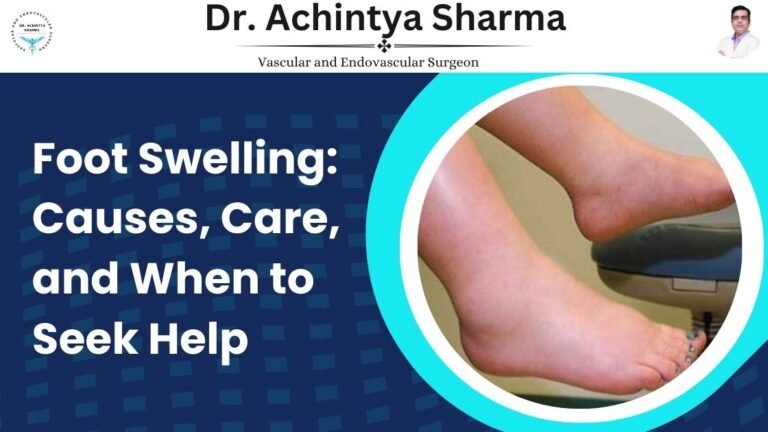Foot disease is one of the most common and dangerous complications faced by people with diabetes. It can start as a minor wound but quickly turn into a serious infection or ulcer. Diabetic patients often suffer from poor blood circulation and nerve damage, which makes foot disease harder to detect and treat. Whether it’s a diabetic foot ulcer or a fungal infection, early identification is key. In this blog, we’ll break down the signs, causes, and differences between foot ulcers and fungal infections. With expert insights from Dr. Achintya Sharma, you’ll learn how to take care of your feet the right way.
Why Diabetic Foot Disease Is a Silent Danger
People with diabetes often face foot problems, and many don’t even realize how common they are. Around 1 in 7 will develop a foot ulcer at some point in life. The problem? Most don’t even feel it coming due to damaged nerves (neuropathy). A small blister can quickly become an open wound, or worse, lead to amputation.
People often confuse diabetic ulcers with fungal infections, delaying the right treatment. Recognizing the type of foot disease early can protect your feet—and your life.
Foot Ulcer or Fungal Infection? How to Know What You’re Dealing With
Let’s understand both conditions clearly.

1. Diabetic Foot Ulcer
- A diabetic foot ulcer is an open sore that usually forms on the bottom of the foot.
- It occurs due to poor blood circulation and nerve damage.
- You may not feel pain, but the area may look red, swollen, or have pus.
- These ulcers take time to heal and can easily get infected.
- If untreated, they can lead to gangrene or amputation.
2. Fungal Infection (Athlete’s Foot)
- A fungal infection usually starts between the toes and is caused by a type of fungus that grows in warm, damp areas.
- Symptoms include itching, peeling skin, redness, and a foul smell.
- While not as serious as an ulcer, it can spread quickly.
- It may look like cracked or flaky skin but can open the door to bacterial infections.
So, how do you tell the difference?
- If it’s itchy, flaky, or smelly, it’s likely fungal.
- If the skin between toes looks white and soggy, it’s likely fungal.
- If the area burns or stings, it’s likely fungal.
- If there’s a deep wound with hard edges, it could be a diabetic foot ulcer.
- If the foot feels numb or has no sensation, it could be a diabetic foot ulcer.
- If there’s an open sore, swelling, or no pain at all, it could be a diabetic foot ulcer.
According to Dr. Achintya Sharma, “Many diabetic patients ignore early symptoms. A simple itch might be more than a skin issue. Never guess, consult a foot care specialist.”
Why You Must Act Fast
Ignoring foot disease—even mild symptoms—can lead to severe complications. Here’s what might happen if you delay care:
- Infection may spread to deeper tissues or bones
- Gangrene can set in due to lack of blood flow
- Surgical removal (amputation) might become the only option
- Your ability to walk or live independently may be affected
The good news? Most cases are preventable and treatable when diagnosed early. Proper foot care and regular checkups make all the difference.
Dr. Achintya Sharma recommends diabetic patients perform a daily self-exam. “Look at the soles, toes, and nails. If you see something unusual, like a cut that doesn’t heal or flaky skin, don’t wait—get it checked,” he advises.
How to Protect Your Feet from Serious Diabetic Complications:

If you’re diabetic or have a loved one who is, take these simple steps to prevent foot disease:
Daily Foot Checks
Look for cuts, blisters, redness, swelling, or skin changes. Use a mirror if needed.
Keep Feet Clean and Dry
Wash your feet daily with mild soap and dry them, especially between the toes.
Trim Toenails Carefully
Cut straight across. Never cut too deep or around corners.
Moisturize (But Not Between Toes)
Dry skin cracks easily. Use lotion, but avoid moistening between toes, where fungi grow.
Wear Proper Footwear
Avoid tight shoes or walking barefoot. Choose soft, well-fitted diabetic-friendly shoes.
See a Specialist
Don’t rely on home remedies. Visit a podiatrist regularly. Dr. Achintya Sharma, an expert in diabetic foot care, can diagnose and treat foot issues before they become life-threatening.
Conclusion:
Foot disease caused by diabetes is more dangerous than it seems. A small infection or sore can escalate into a severe ulcer or even require amputation. Whether it’s a diabetic foot ulcer or a fungal infection, knowing the symptoms and taking quick action is vital. Daily foot care, wearing proper shoes, and regular medical checkups can prevent foot disease caused by diabetes. Dr. Achintya Sharma advises, “Taking care of your feet early can prevent serious problems later.” If you have diabetes, never ignore foot changes. Keep an eye on them, take daily care, and if something feels off, don’t wait, see a doctor.




